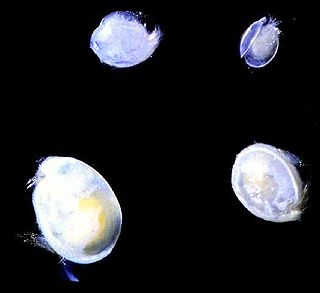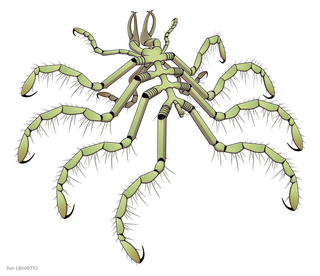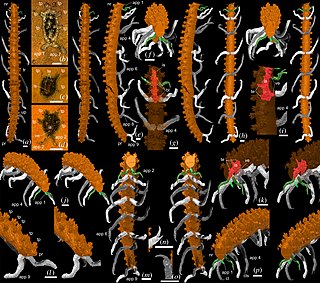Traditionally, the Myodocopa and Podocopa have been classified as subclasses within the class Ostracoda, although there is some question about how closely related the two groups actually are. The Myodocopa are defined by possession of a poorly calcified carapace, and 8–9 articles in the exopod of the second antenna. The ventral margin of the carapace is not concave, and the valves do not overlap to a great extent.

Cylindroleberididae is a family of ostracods that shows remarkable morphological diversity. The defining feature is the possession of gills: 7–8 leaf-like pairs at the posterior of the body. Other features common to all species in the family include a "baleen-comb" on both the maxilla and the fifth limb, a sword-shaped coxal endite on the mandible, and the triaenid bristles on the basal endites of the mandible.

Synziphosurina is a paraphyletic group of chelicerate arthropods previously thought to be basal horseshoe crabs (Xiphosura). It was later identified as a grade composed of various basal euchelicerates, eventually excluded from the monophyletic Xiphosura sensu stricto and only regarded as horseshoe crabs under a broader sense. Synziphosurines survived at least since early Ordovician to early Carboniferous in ages, with most species are known from the in-between Silurian strata.
Cinerocaris is an extinct genus of phyllocarid crustaceans known from the Silurian aged Coalbrookdale Formation in Herefordshire, England. It contains the species Cinerocaris magnifica.
Pauline avibella is a fossil ostracod from the Silurian with unusually well preserved soft parts, including limbs, eyes, gills and alimentary system.
Pauline is a fossil genus of ostracods from the Silurian. Genus contains two species: Pauline avibella found in 425-million-year-old rocks in the Herefordshire Lagerstätte in England near the Welsh Border and Pauline nivisis, known from the Lower Silurian Pentamerus Bjerge Formation of north Greenland.

Invavita piratica is an extinct, parasitic species of tongue worm, provisionally assigned to the order Cephalobaenida, from Herefordshire Lagerstätte, Ludlow-aged England. It possessed a head, a worm-like body, and two pairs of limbs.

Oligostraca is a superclass of crustaceans. It consist of the following three classes:

Prosomapoda is a clade of euchelicerates including the groups Xiphosura and Planaterga, as well as several basal synziphosurid genera. The clade is defined by the lack of exopods of prosomal appendage II-V in the adult instar, where in contrast the exopods of appendage II-V are well-developed in the non-prosomapod euchelicerates Offacolus and Dibasterium.

Offacolus is an extinct genus of euchelicerate, a group of chelicerate arthropods. Its only species, O. kingi, has been found in deposits from the Silurian period in the Wenlock Series Lagerstätte of Herefordshire, England. The genus is named after Offa, a king from the ancient kingdom of Mercia, and colus, a person who dwelled among the Offa's Dyke. The species name honors Robert Joseph King, a British mineralogist who found the fossils of Offacolus.

Haliestes is a genus of sea spider from the Silurian aged Coalbrookdale Formation of England. It contains a single species, Haliestes dasos. The species was first described by David Siveter et al. in 2004. It is considered to be a nektonic predator.

Sollasina is an extinct genus of ophiocistioid that is known from Silurian to Devonian.

Dibasterium is an extinct genus of euchelicerate, a group of chelicerate arthropods. Fossils of the single and type species, D. durgae, have been discovered in the Coalbrookdale Formation of the Middle Silurian period in Herefordshire, England. The name of the genus is derived from the Latin words dibamos and mysterium ("mystery"), meaning "mystery on two legs" and referring to its prosomal limbs. The species name durgae comes from Durga, a Hindu goddess with many arms.

Thanahita is a genus of extinct lobopodian and known from the middle Silurian Herefordshire Lagerstätte at the England–Wales border in UK. It is monotypic and contains one species, Thanahita distos. Discovered in 2018, it is estimated to have lived around 430 million years ago and is the only known extinct lobopodian in Europe, and the first Silurian lobopodian known worldwide.

Hallucigeniidae is a family of extinct worms belonging to the group Lobopodia that originated during the Cambrian explosion. It is based on the species Hallucigenia sparsa, the fossil of which was discovered by Charles Doolittle Walcott in 1911 from the Burgess Shale of British Columbia. The name Hallucigenia was created by Simon Conway Morris in 1977, from which the family was erected after discoveries of other hallucigeniid worms from other parts of the world. Classification of these lobopods and their relatives are still controversial, and the family consists of at least four genera.

Coalbrookdale Formation, earlier known as Wenlock Shale or Wenlock Shale Formation and also referred to as Herefordshire Lagerstätte in palaeontology, is a fossil-rich deposit (Konservat-Lagerstätte) in Powys and Herefordshire at the England–Wales border in UK. It belongs to the Wenlock Series of the Silurian Period within the Homerian Age. It is known for its well-preserved fossils of various invertebrate animals many of which are in their three-dimensional structures. Some of the fossils are regarded as earliest evidences and evolutionary origin of some of the major groups of modern animals.
Carbotubulus is a genus of extinct worm belonging to the group Lobopodia and known from the Carboniferous Carbondale Formation of the Mazon Creek area in Illinois, US. A monotypic genus, it contains one species Carbotubulus waloszeki. It was discovered and described by Joachim T. Haug, Georg Mayer, Carolin Haug, and Derek E.G. Briggs in 2012. With an age of about 300 million years, it is the first long-legged lobopodian discovered after the period of Cambrian explosion.

Enalikter is an extinct arthropod described from the middle Silurian Herefordshire Lagerstätte at the England–Wales border in UK. This genus is known from only one species, E. aphson. Enalikter is described as late-living example of Megacheira, "great-appendage arthropod". It subsequently suggested to be an annelid by other researchers, however subsequent studies rejected this interpretation. Its interpretation as megacheiran arthropod has been questioned in later studies.

Enaliktidae is an extinct family of elongate arthropods known from the Silurian and Devonian periods, containing two genera, Enalikter and Bundenbachiellus. Taxonomic positions of the family is uncertain and in its original description it was attributed to the Megacheira, a group of arthropods otherwise known from the Cambrian period, due to them possessing uniramous frontal appendages with whip-like exensions, similar to the great appendages of megacheirans belonging to the family Leanchoiliidae like Leanchoilia. However, their placement as megacheirans has been questioned, as they arguably lack any defining apomorphies of that group, as whether the great appendages of megacheirans and the frontal appendages of enaliktids are homologous is unclear.
Tanazios is a genus of Silurian stem-mandibulate.











